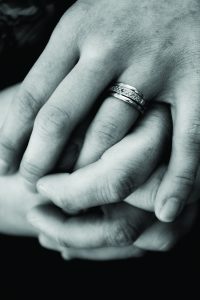Tina Cady never thought she would be buying her wedding shoes at Target the night before getting married. She never thought she would have strangers attending her ceremony and handing her flowers. She never thought her reception would take place at Starbucks. And she never thought she would be signing her certificate as the groom.
She never thought she would be getting married at all.
The day before they said “I do,” Tina and Cody Cady’s marriage would have been illegal in Wisconsin and in much of the country, but on June 26, 2015, the U.S. Supreme Court decreed bans on same-sex marriage to be unconstitutional, resulting in a prominent civil rights victory that changed the lives of more than 8 million LGBT people in the U.S.
The pair had been planning to get married, but when they heard the news on the radio that Friday night, they announced that they would be getting hitched the next morning.
“We called it our flash mob wedding because we didn’t know,” Tina says. “We ran around that night at Target at 11 p.m. We had nothing.”
Their wedding day was filled with love, joy and support from the community, but it was a day neither Tina nor Cody was sure they would ever see. And while same-sex marriage has now been legal in the U.S. for more than a year, it was a hard-fought battle to get there and a long road still lies ahead for LGBT equality. Gay and lesbian couples still face inequalities within the marriage institution, and the community continues to deal with discrimination despite the positive change in public opinion.
“I honestly didn’t know if I would ever see gay marriage, ever, growing up,” Tina says.
While Cody’s family was unable to attend the wedding because of the short notice, Tina’s parents served as the witnesses. The couple posted an invitation on Facebook announcing that the ceremony would take place at 9 a.m. The courthouse, which is typically closed on a Saturday, was opened to allow people to apply for their marriage licenses. The waiting period, which is typically five days, was waived. Judges, lawyers and other licensed officiates stood outside the courthouse and volunteered their time to marry the many couples who came to celebrate their love and the long-anticipated victory of marriage equality that they had been waiting for for so long.
Many of Tina and Cody’s guests were strangers who were there to be part of the celebration, and the newlyweds were surrounded by people expressing their quick congratulations as the bustle of the Farmers’ Market surrounded them. A 5-year-old girl picked flowers from her mother’s garden to hand out; the sentiment seemed to be that on this day, June 27, 2015, no one should get married without flowers.
“We didn’t have any fuss,” Tina says. “We just brushed our hair and put on mascara and got married.”
When Tina came out to her friends and family in 1996, Ellen DeGeneres was on TV about to come out as a lesbian, and Hawaii was in the midst of one of the first same-sex marriage legal battles. In that same year, then-President Bill Clinton also signed the Defense of Marriage Act into law.
The federal law defined marriage as a heterosexual union between a man and a woman. While states still had the ability to recognize same-sex marriage, those that did not could deny rights to a couple married in a state that did recognize it, and any federal marriage benefits were denied to same-sex couples.
“For a minute it felt really hopeful, and then it felt really unhopeful,” Tina says.
That act set the stage for the legal battles waged in each state for the next 20 years, and Wisconsin has a back-and-forth history in its attempts to both ban and legalize same-sex marriage.
In 2006, Wisconsin voters approved a constitutional amendment banning same-sex marriage 59 to 41 percent. Just three years later, Wisconsin established a state domestic partner registry that granted a few limited legal rights to same-sex partners, such as hospital visitation and the ability to make end-of-life decisions. Most rights and benefits, however, remained accessible only by marriage. In 2013, the Supreme Court struck down part of the Defense of Marriage Act, which meant that the federal government could not refuse federal benefits or programs to same-sex couples that were legally married in their states.
On June 6, 2014, a federal judge from the U.S. District Court for the Western District of Wisconsin ruled Wisconsin’s ban on same-sex marriage to be unconstitutional, barring the state from denying same-sex couples the right to get married. In the following week, Wisconsin’s attorney general filed an appeal, which put marriage equality back on hold.
The 2015 U.S. Supreme Court decision that spurred the Cadys’ marriage prevented states from being able to deny rights to couples legally married in their home state and abolished any remaining state bans. But given the difficulties the LGBT community has faced in Wisconsin, regardless of the Supreme Court decision, Tina and Cody saw their marriage as more than just their own celebration.
Because so many state legalizations of same-sex marriage were quickly overturned or put on hold, Tina and Cody thought their window to get married would be short, and they wanted to use that time as an opportunity.
“When we got married was partially a little bit of activism on our part,” Tina says. “We definitely knew that the more people that were in that limbo, the more pressure it puts on the system to figure it out.”
Following their marriage, Tina and Cody faced situations of limbo despite their marriage providing them a status equal to that of straight couples. They first struggled to get on the same insurance, as Tina’s employer at the time did not yet recognize her marriage to Cody. Then, in 2016 — over a year after they got married — they experienced a period of economic hardship in which they tried to apply for food stamps, but were told upon filling out the online application that their marriage was not recognized.
“You have to say ‘unrelated’ or ‘unmarried,’” Cody explains. “And I didn’t want to be like, ‘You’re right, we’re unrelated,’ because we weren’t. We’re married.”
Under the Affordable Care Act, insurance companies must offer the same coverage opportunities to same-sex married couples as heterosexual couples, but for Tina and Cody, issues like these took time to work out, and true equality was not instantaneous.
Tina and Cody would like to eventually start a family eventually, and they have had many concerns about being able to protect their child and their rights as parents under current laws?.
“Both being able to be on the birth certificate is really important because that’s not just about us,” Cody says. “That’s about our kid and what happens to them, that’s not their decision.”
Although some couples are still fighting custody battles, in September 2016, the federal U.S. District Court for the Western District of Wisconsin ruled that in Wisconsin, both parents in a same-sex marriage must be listed on a birth certificate in cases of artificial insemination, granting couples like Tina and Cody the peace of mind that their child will be protected by the custody of both parents.
Their marriage is legal in the eyes of the law, but the ancient institution has been slow to accommodate what has for so long been defined as an institution belonging to “one man and one woman.” While the technicalities continue to be worked out, it is still considered a victory by Tina, Cody and others in the community.
“LGBT people have been second-class citizens for a long time,” says Steve Starkey, executive director of South Central Wisconsin’s OutReach LGBT Community Center. “A lot of people think of marriage as a religious institution, but really it’s a legal and financial institution and it provides over a thousand different rights to people who are married. … It was a big deal for the community.”
But the LGBT community still faces significant barriers and discrimination, so what comes next?
In 1982, Wisconsin became the first state to pass laws preventing discrimination based on sexual orientation in employment, housing and public accommodations, but these laws do not protect the entire LGBT community.
“When that law was enacted, it was for gays and lesbians, and it did not include transgender people, and it was never updated to include transgender people,” Starkey says. “So a transgender person can be fired for being transgender. They can be kicked out of their housing for being transgender. They can be refused public accommodations like hotels or any kind of public services. So I think that’s something that we really need to work on.”
Starkey says that although Madison and other large, liberal cities are more accommodating and provide a greater number of resources for the LGBT community, that is not the case in many areas of the country and rural parts of the state.
“I think that’s another issue for us is being able to have the same type of rights and culture and community anywhere in the country instead of only having pockets of areas where we are safe or where we have the services that we need,” Starkey says.
When it comes to some of these barriers and the history of discrimination that LGBT people have faced, for Tina and Cody Cady, it comes down to a uniquely simple yet incredibly complex question they raise.
“We just want to be happy like anyone else and have a family like anyone else, and why is that such a big deal?” Cody asked. “It’s really important for people to be like ‘Well, you’re not that scary. You’re not that different from me. I was wrong.’”
 [/vc_column_text][/vc_column][/vc_row]
[/vc_column_text][/vc_column][/vc_row]
Tyne Oberlander

When Tyne isn’t furiously working to complete and perfect whatever journalism school project is on her desk, her top priorities consist of scouring the internet for articles about Harry Potter, Gilmore Girls and Game of Thrones, asking her mom to send pictures of her dogs, plotting her next meal or smashing the patriarchy. Tyne is studying strategic communication and gender and women’s studies, but also recreationally studies North Dakota history as a proud native of the state. Although she’s graduating in May 2017, Tyne awaits the opportunity to continue to be a lifelong learner.


